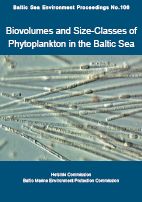Biovolumes and Size-Classes of Phytoplankton in the Baltic Sea
 The report on biovolumes and size-classes of phytoplankton in the Baltic Sea has been produced by the HELCOM Phytoplankton Expert Group (PEG). Most laboratories involved in the HELCOM Baltic Monitoring Programme (COMBINE) have contributed to the work, using regional phytoplankton data. Distinct size-classes and biovolumes were agreed upon and established for most Baltic species which are possible to identify using a light microscope and the Utermöhl counting technique.
The report on biovolumes and size-classes of phytoplankton in the Baltic Sea has been produced by the HELCOM Phytoplankton Expert Group (PEG). Most laboratories involved in the HELCOM Baltic Monitoring Programme (COMBINE) have contributed to the work, using regional phytoplankton data. Distinct size-classes and biovolumes were agreed upon and established for most Baltic species which are possible to identify using a light microscope and the Utermöhl counting technique.
The need for a comprehensive compilation was recognised already at the beginning of the phytoplankton studies in the framework of the Baltic Monitoring Programme. Since quality assurance of data is an important component of the HELCOM monitoring programme, measures were taken to evaluate and improve the recommended methods through intercalibrations between the different partners. In 1991 HELCOM PEG was established, with the main aim to unify methods of collection, counting and identification of phytoplankton species. Since accurate biomass estimates are important in phytoplankton monitoring, PEG also made considerable efforts to standardise size-classes and biovolumes of phytoplankton species found in the Baltic Sea.
It is recommended that the present list with biovolumes and fixed size-classes be used for the calculation of phytoplankton biomass in routine monitoring of Baltic Sea phytoplankton and the aim is for it to become an integral component of HELCOMs phytoplankton counting programme, PhytoWin. The list will be updated as new information is obtained.
The use of a standardised species list with fixed size-classes and biovolumes will be a decisive measure for improving the quality of the phytoplankton counting method and the comparability of results.
Click here to view the latest phytoplankton biovolumes list (updated 2008).
Also see the HELCOM Indicator Fact Sheets:
Shifts in the Baltic Sea summer phytoplankton communities in 1992-2006
Unusual phytoplankton event during winter-spring 2007-2008
Last updated 1 October 2009

